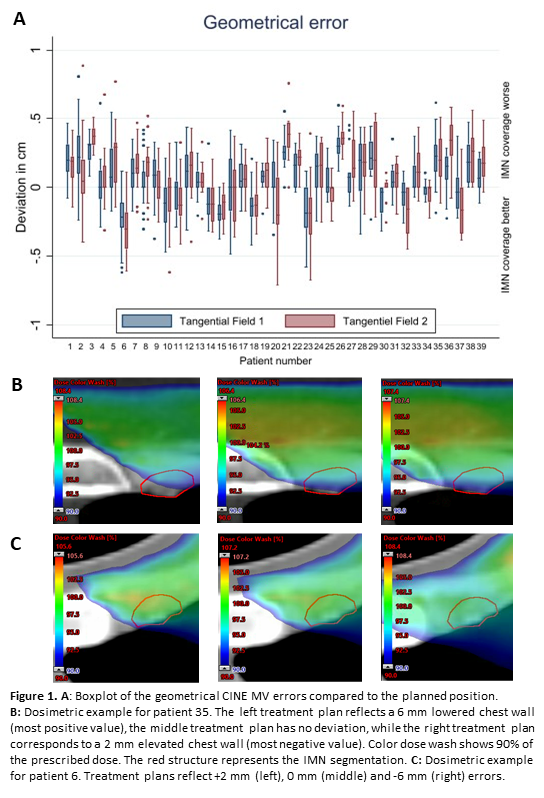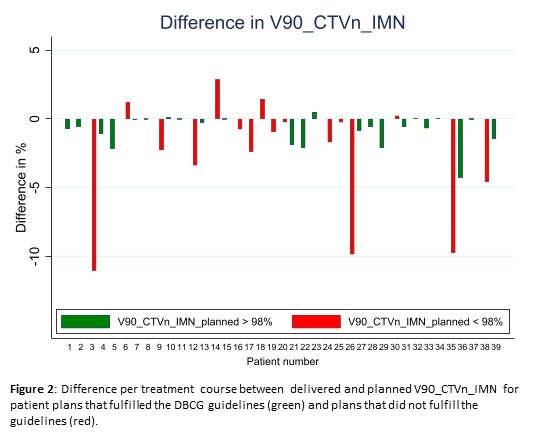Intrafractional dose coverage of the internal mammary nodes in high-risk breast cancer patients
Anders W. Mølby Nielsen,
Denmark
PD-0237
Abstract
Intrafractional dose coverage of the internal mammary nodes in high-risk breast cancer patients
Authors: Anders W. Mølby Nielsen1, Harald Spejlborg2, Per Rugaard Poulsen3,4, Birgitte Vrou Offersen1,4,3
1Aarhus University Hospital, Department of Experimental Clinical Oncology, Aarhus, Denmark; 2Aarhus University Hospital, Department of Medical Physics, Aarhus, Denmark; 3Aarhus University Hospital, Danish Center for Particle Therapy, Aarhus, Denmark; 4Aarhus University Hospital, Department of Oncology, Aarhus, Denmark
Show Affiliations
Hide Affiliations
Purpose or Objective
Internal mammary node (IMN) irradiation in high-risk breast cancer patients improves overall survival. The Danish Breast Cancer Group (DBCG) guidelines for adjuvant breast cancer radiotherapy recommend ≥98% of the IMN CTV receives 90% of the prescribed dose (V90_CTVn_IMN). No PTV dose coverage is required. This leaves little room for intrafractional movements. This study examines the delivered IMN dose coverage at treatment using continuous portal images (CINE MV) of tangential breast fields.
Material and Methods
A prospective single-center quality assurance study was conducted in a consecutive cohort of left-sided node-positive breast cancer patients treated during 2021 using a wide tangential field technique under deep-inspiration breath-hold (DIBH). During treatment delivery, CINE MV images were recorded at every fraction for the medial and lateral tangential primary field. On the final frame of each CINE MV recording the chest wall was matched with the Digital Reconstructed Radiograph (DRR) from the planning CT scan, resulting in two observations of the chest wall positional error per fraction. The match was performed at the chest wall level closest to the IMN target. The geometrical errors were rounded to integer millimeters and binned. For each 1 mm bin a new treatment plan was recalculated assuming that the error observed in the 2D CINE MV image was caused by a vertical chest wall shift in the IMN region. This allowed for a weighted plan sum recalculation of the delivered V90_CTVn_IMN. The primary outcome was the difference between delivered and planned V90_CTVn_IMN.
Results
In total, 39 breast cancer patients, 37 females, were included for analysis. The median age was 59 years (range 27-86). Mastectomy and breast conserving therapy was performed in 21 and 18 patients, respectively. Twenty-seven patients were treated with 40Gy/15fx and 12 patients with 50Gy/25fx. Simultaneous integrated boost was given to 8 patients.
The mean number of CINE MV observations per patient was 36 (range 26-55). Most patients (67%) had on average a lowered chest wall position on CINE MV images compared to the plan, which is shown as worse IMN coverage in figure 1. This translated into a statistically significant reduction of the delivered mean V90_CTVn_IMN of 1.54 % (95% CI, 0.59-2.48; p=0.002) compared to the planned dose. The V90_CTVn_IMN reduction was >3 % in six patients and >9 % in three patients, figure 2. The delivered mean lung dose was reduced by 0.28% (95% CI, 0.09-0.46; p=0.004) compared to the planned dose. The mean heart dose was 1.4 Gy, both delivered and planned.

Conclusion
Using CINE MV images, we found that the delivered V90_CTVn_IMN was significantly lower than planned. In 8 % of the patients the V90_CTVn_IMN reduction exceeded 9 %. No clinically relevant differences were found for the mean lung dose or mean heart dose. Based on these data our institution expects to implement cone beam CT as daily image guided RT in high-risk breast cancer patients.
